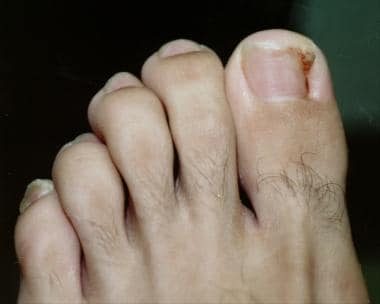Practice Essentials
Ingrown toenails (unguis incarnatus), or onychocryptosis, are a common problem, and causes include poorly fitting (tight) footwear, infection, improperly trimmed toenails, trauma, and heredity. The great toe is the most commonly involved, [1] with the lateral side being involved more commonly than the medial side. [2, 3, 4] The ingrown nail is often diagnosed in schoolchildren, adolescents, young adults, and pregnant women. [1] The underlying cause of this condition is a foreign body reaction. When the nail bed is compressed from the side, the edge of the nail penetrates the cuticle. A foreign body reaction is set up by the presence of the keratinaceous nail material in the flesh of the toe. [5, 6]
Ingrowth of the toenail is generally thought to be multifactorial, including the following:
-
Nail length: Cutting the nail so short that it is not constrained by the distal portion of the cuticles, allowing side slippage and penetration of the lateral nail bed by the nail substance.
-
External pressure: Wearing shoes that are so tight that they compress the ridges of the cuticles against the relatively stiff nail material, turning the nail into a cutting surface.
There are 3 stages of ingrown nails, as follows [7] :
-
Stage 1: Mild erythema edema and pain with pressure.
-
Stage 2: Significant erythema, edema, local infection, and discharge.
-
Stage 3: Granulation tissue formation and hypertrophy of the lateral wall besides the significant erythema, edema, and discharge.
This disorder is not found in the preambulatory stages. Rare in preteens, it is more common in teenagers, and its occurrence increases throughout life. Patients with an ingrown toenail have a painful, swollen, and tender toe. When infection is present, the patient may have local discharge. Important components of the history include a previous history of risk factors for diabetes and arterial insufficiency. The affected toe has all the classic signs of infection: pain, edema, erythema, and warmth. Lymphangitis is rare. The affected side is readily apparent. Inspection for other contributing causes, particularly mycoses, is important.
Radiography should be considered when it is necessary to rule out osteomyelitis (rare) or in the setting of trauma to rule out toe fractures (common).
Management
Packing, taping, gutter treatment, and nail braces are options for relatively mild cases of ingrown toenails, whereas surgery is exclusively done by physicians, and phenolization of the lateral matrix horn is now the safest, simplest, and most commonly performed method with the lowest recurrence rate. [8, 9, 10, 11, 12, 13, 14] Nail phenolization is indicated when partial and definitive removal of the nail plate is necessary. [10, 11]
Lateral plate avulsion with chemical matricectomy is considered the treatment of choice for ingrown toenails. Phenol is the most widely used cauterant, followed by 10% sodium hydroxide, and then trichloroacetic acid. Phenol is effective but associated with prolonged postoperative drainage. Sodium hydroxide is considered to be equally efficacious as phenol but has the side effect of intense pain in the initial days after treatment. Trichloroacetic acid has also been found to be as efficacious as phenol. [11, 15, 16, 17]
(An ingrown toenail is shown in the photo below.)
Follow-up and prevention
The principal morbid condition of ingrown toenail is pain. However, it can be the initiating pathway for more serious disorders in certain patients at risk, especially those with diabetes or arterial insufficiency. Particular attention must be paid to high-risk patients. Referral to specialty clinics for follow-up (eg, surgeon, podiatrist) is recommended for these patients.
Preventive measures include the use of properly fitted footwear and correct trimming of nails. Shoes should have a toe box large enough to fit the toes without pressure and to allow for normal spreading of the toes with walking. Nails should be cut straight across with clean, sharp, preferably bullnose-type nail trimmers (curve is reverse of common fingernail clippers). Nails should not be cut shorter at the lateral edges.
Recurrence and/or regrowth of the treated side occurs in 10-30% of cases. According to a Cochrane Database review, surgical interventions are more effective than nonsurgical interventions in preventing ingrown toenail recurrence. Postoperative treatments generally do not reduce the risk of infection, nor do they shorten healing time. [18]
-
Appearance of typical ingrown toenail.
-
Cutting the nail.
-
Cauterizing the matrix.
-
Appearance of toenail at end of the cauterizing procedure.






